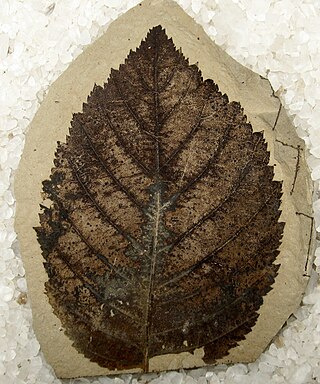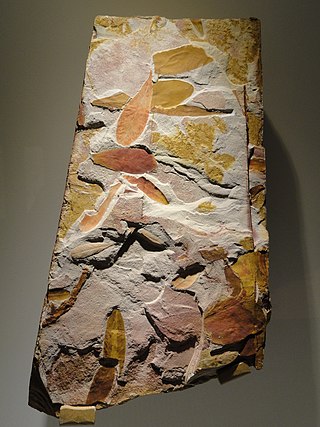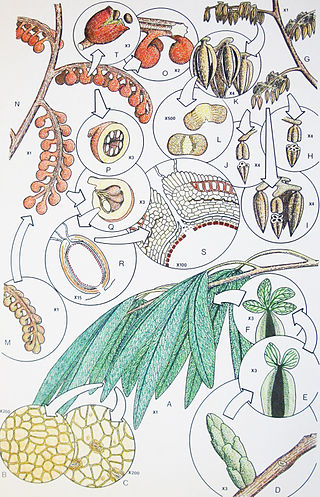
Ginkgoales are a gymnosperm order containing only one extant species: Ginkgo biloba, the ginkgo tree. It is monotypic, within the class Ginkgoopsida, which itself is monotypic within the division Ginkgophytaghing-KOF-it-ə. The order includes five families, of which only Ginkgoaceae remains extant.

Paleobotany, also spelled as palaeobotany, is the branch of botany dealing with the recovery and identification of plant remains from geological contexts, and their use for the biological reconstruction of past environments (paleogeography), and the evolutionary history of plants, with a bearing upon the evolution of life in general. A synonym is paleophytology. It is a component of paleontology and paleobiology. The prefix palaeo- or paleo- means "ancient, old", and is derived from the Greek adjective παλαιός, palaios. Paleobotany includes the study of terrestrial plant fossils, as well as the study of prehistoric marine photoautotrophs, such as photosynthetic algae, seaweeds or kelp. A closely related field is palynology, which is the study of fossilized and extant spores and pollen.

Glossopteris is the largest and best-known genus of the extinct Permian order of seed plants known as Glossopteridales. The genus Glossopteris refers only to leaves, within a framework of form genera used in paleobotany. Species of Glossopteris were the dominant trees of the middle to high-latitude lowland vegetation across the supercontinent Gondwana during the Permian Period. Glossopteris fossils were critical in recognizing former connections between the various fragments of Gondwana: South America, Africa, India, Australia, New Zealand, and Antarctica.

Bennettitales is an extinct order of seed plants that first appeared in the Permian period and became extinct in most areas toward the end of the Cretaceous. Bennettitales were amongst the most common seed plants of the Mesozoic, and had morphologies including shrub and cycad-like forms. The foliage of bennettitaleans is superficially nearly indistinguishable from that of cycads, but they are distinguished from cycads by their more complex flower-like reproductive organs, at least some of which were likely pollinated by insects.

Cheirolepidiaceae is an extinct family of conifers. They first appeared in the Triassic, and were widespread during most of the Mesozoic era. They are united by the possession of a distinctive pollen type assigned to the form genus Classopollis. The name Frenelopsidaceae or "frenelopsids" has been used for a group of Cheirolepidiaceae with jointed stems, thick internode cuticles, sheathing leaf bases and reduced free leaf tips. The leaf morphology has been noted as being similar to that of halophyte Salicornia. Several members of the family appear to have been adapted for semi-arid and coastal settings, with a high tolerance of saline conditions. Cheirolepidiaceae disappeared from most regions of the world during the Cenomanian-Turonian stages of the Late Cretaceous, but reappeared in South America during the Maastrichtian, the final stage of the Cretaceous, increasing in abundance after the K-Pg extinction and being a prominent part of the regional flora during the Paleocene, before going extinct.

The Caytoniales are an extinct order of seed plants known from fossils collected throughout the Mesozoic Era, around 252 to 66 million years ago. They are regarded as seed ferns because they are seed-bearing plants with fern-like leaves. Although at one time considered angiosperms because of their berry-like cupules, that hypothesis was later disproven. Nevertheless, some authorities consider them likely ancestors or close relatives of angiosperms. The origin of angiosperms remains unclear, and they cannot be linked with any known seed plants groups with certainty.

Caytonia is an extinct genus of seed ferns.

Sagenopteris is a genus of extinct seed ferns from the Triassic to late Early Cretaceous.

The Medullosales is an extinct order of pteridospermous seed plants characterised by large ovules with circular cross-section and a vascularised nucellus, complex pollen-organs, stems and rachides with a dissected stele, and frond-like leaves. Their nearest still-living relatives are the cycads.

The Lyginopteridales are an extinct group of seed plants known from the Paleozoic. They were the first plant fossils to be described as pteridosperms and, thus, the group on which the concept of pteridosperms was first developed; they are the stratigraphically oldest-known pteridosperms, occurring first in late Devonian strata; and they have the most primitive features, most notably in the structure of their ovules. They probably evolved from a group of Late Devonian progymnosperms known as the Aneurophytales, which had large, compound frond-like leaves. The Lyginopteridales became the most abundant group of pteridosperms during Mississippian times, and included both trees and smaller plants. During early and most of middle Pennsylvanian times the Medullosales took over as the more important of the larger pteridosperms but the Lyginopteridales continued to flourish as climbing (lianescent) and scrambling plants. However, later in Middle Pennsylvanian times the Lyginopteridales went into serious decline, probably being out-competed by the Callistophytales that occupied similar ecological niches but had more sophisticated reproductive strategies. A few species continued into Late Pennsylvanian times, and in Cathaysia and east equatorial Gondwana they persisted into the Late Permian, but subsequently became extinct. Most evidence of the Lyginopteridales suggests that they grew in tropical latitudes of the time, in North America, Europe and China.

Edna Pauline Plumstead was a South African palaeobotanist, of the Bernard Price Institute for Palaeontological Research, University of the Witwatersrand, Johannesburg, where she graduated in 1924. Edna lived in Cape Town the first seven years of her life and that is where she would explore and find wild flowers in the Cape Peninsula. Plumstead would later on connect the wild flowers to the same one in places like Australia and South America when she would later on defend the continental drift. She first began defending the theory of continental drift in the 1950s and has been described as one 'of South Africa's foremost scientists in the field of Gondwana paleobotany and geology'. Plumstead was awarded the Chrestian Mica Gondwanaland Medal by the Geological Society of India, and was made a Fellow of the Royal Society of South Africa.

Dicroidium is an extinct genus of fork-leaved seed plants. It is the archetypal genus of the corystosperms, an extinct group of seed plants, often called "seed ferns", assigned to the order Corystospermales or Umkomasiales. Species of Dicroidium were widely distributed and dominant over Gondwana during the Triassic. Their fossils are known from South Africa, the Arabian Peninsula, Australia, New Zealand, South America, Madagascar, the Indian subcontinent and Antarctica.
Emplectopteridaceae is an extinct family of pteridosperms known mainly from Permian floras of the Cathaysian Realm. They were mostly shrubby plants with a scrambling or upright habit, and favoured a range of habitats from arid to moist or even aquatic.

Lepidopteris is a form genus for leaves of Peltaspermaceae, an extinct family of seed plants, which lived from around 260 to 190 million years ago, from the Late Permian to Early Jurassic. Fossils of the genus have been found across both hemispheres. Nine species are currently recognized.Lepidopteris was a common and widespread seed fern, which survived the Permian-Triassic extinction event but was largely wiped out by the Triassic-Jurassic extinction event. Lepidopteris callipteroides is especially common between the first two episodes of Permian-Triassic extinction event, and L. ottonis forms a comparable acme zone immediate before the Triassic-Jurassic extinction event. Lepidopteris would persist into the Early Jurassic in Patagonia, represented by the species Lepidopteris scassoi.

The Peltaspermales are an extinct order of seed plants, often considered "seed ferns". They span from the Late Carboniferous to the Early Jurassic. It includes at least one valid family, Peltaspermaceae, which spans from the Permian to Early Jurassic, which is typified by a group of plants with Lepidopteris leaves, Antevsia pollen-organs, and Peltaspermum ovulate organs, though the family now also includes other genera like Peltaspermopsis, Meyenopteris and Scytophyllum. Along with these, two informal groups of uncertain taxonomic affinities exist, each centered around a specific genus ; Supaia and Comia, known from the Early Permian of the Northern Hemisphere, especially of North America. Both the "Comioids" and the "Supaioids" are associated with the peltaspermacean ovulate organ Autunia. The Late Triassic-Middle Jurassic genus Pachydermophyllum may also have affinities to the peltasperms.

Umkomasia macleanii is an ovulate structure of a seed fern (Pteridospermatophyta and the nominate genus of Family Umkomasiaceae. It was first described by Hamshaw Thomas from the Umkomaas locality of South Africa.

Pteruchus africanus is a pollen organ of a seed fern (Pteridospermatophyta). It was first described by Hamshaw Thomas from the Umkomaas locality of South Africa.

Pteruchus is a form genus for pollen organs of the seed fern (Pteridospermatophyta family Umkomasiaceae. It was first described by Hamshaw Thomas from the Umkomaas locality of South Africa. It is associated with the seed bearing organs Umkomasia and Dicroidium leaves.

Corystosperms are a group of extinct seed plants belonging to the family Corystospermaceae assigned to the order Corystospermales or Umkomasiales. They were first described based on fossils collected by Hamshaw Thomas from the Burnera Waterfall locality near the Umkomaas River of South Africa. Corystosperms are typified by a group of plants that bore forked Dicroidium leaves, Umkomasia cupulate ovulate structures and Pteruchus pollen organs, which grew as trees that were widespread over Gondwana during the Middle and Late Triassic. Other fossil Mesozoic seed plants with similar leaf and/or reproductive structures have also sometimes been included within the "corystosperm" concept sensu lato, such as the "doyleoids" from the Early Cretaceous of North America and Asia. A potential corystosperm sensu lato, the leaf genus Komlopteris, is known from the Eocene of Tasmania, around 53-50 million years old, over 10 million years after the Cretaceous–Paleogene extinction event.

Komlopteris is an extinct genus of "seed fern" with possible corystosperm affinities. Fossils have been found across both hemispheres, dating from the latest Triassic to the early Eocene (Ypresian), making it the youngest "seed fern" in the fossil record.






















